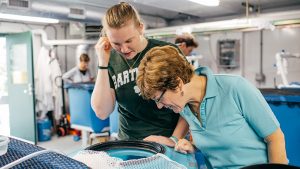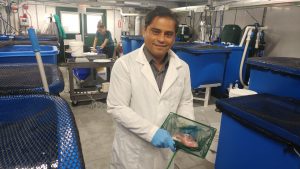Affectionately dubbed the “Fishbarn” our fully recirculating aquaculture lab is the front line for our work on formulating sustainable aquafeeds.
What are we working towards?
In 2014, Kapuscinski and Sarker discovered a potential game changer for shifting aquaculture, the world’s fastest growing food sector, from unsustainable to more sustainable practices. Conventional aquafeeds use fishmeal and fish oil extracted from small ocean fish or “forage fish,” such as sardines. Aquafeeds, a USD 24 billion industry in 2014, use approximately 70% of the world supply of fish oil and fishmeal. Extraction of these commodities from 25% of the world’s fisheries catch, mostly from wild marine fish, diverts these healthy sources of protein and omega-3 fatty acids from the human food supply. This undermines food security in 36 countries; is raising prices of fishmeal and fish oil; and threatens seabirds, tuna and other valuable large fish which feed on the same marine fish. The UN forecasts global supplies to run out by 2040 at the current rates of demand. The world needs affordable and truly sustainable substitutes for fish oil and fishmeal.
Motivated by this enormous challenge, we aim to produce a fish-free diet using marine microalgae. We discovered that certain marine microalgae can replace the fish oil in aquafeeds for tilapia, the world’s second most farmed fish; and shows promise for rainbow trout and salmon. Fish fed our microalgae diets show equal or better growth, food conversion, and protein use efficiency than fish fed conventional diets. These results suggest our microalgae-feed formulas can improve the sustainability and reduce costs of tilapia farming. We are now testing replacement of fishmeal with other microalgae, using the “co-product” biomass left over after extracting omega-3 oil for nutraceuticals. Recent studies have generated a patent application (Kapuscinski and Sarker 2016) and scientific articles (Sarker et al. 2016a, Sarker et al. 2016b). We are continuing this work with a major USDA grant (Sarker and Kapuscinski 2016). We are developing a tilapia “digestion simulator” (in vitro) to accelerate development of sustainable aquafeeds; and are testing brewery wastewater as environmentally beneficial, cheaper fertilizer for microalgae production. Our laboratory has state-of-the-art recirculating aquaculture systems and data recording.
Why Tilapia?
 Tilapia are the second most widely produced fish in the world, and increasingly there are becoming less nutritious. Fish, most famously salmon, help provide people Omega-3 fatty acids, a key aspect in a well balanced healthy diet. However, terrestrial plant contributions and other animal by-products in their feed have lead to higher than normal levels of long chain-6 fatty acids; rather than the Omega-3’s most people eat fish to gain.
Tilapia are the second most widely produced fish in the world, and increasingly there are becoming less nutritious. Fish, most famously salmon, help provide people Omega-3 fatty acids, a key aspect in a well balanced healthy diet. However, terrestrial plant contributions and other animal by-products in their feed have lead to higher than normal levels of long chain-6 fatty acids; rather than the Omega-3’s most people eat fish to gain.
As a cultured species, tilapia are perfect; they are hardy, fast growing, and prolific. These fish can maintain reasonable growth in sub-optimal living conditions and with poor feed content, and impressive rates in optimal water quality with a nutritious diet.
Their widespread popularity as a food source, success as a culture species, and declining nutritional quality make them an ideal candidate. By providing a microalgae based diet we can improve the ratio of omega-3 to long chain-6 fatty acids, and reduce their overall environmental impact.


